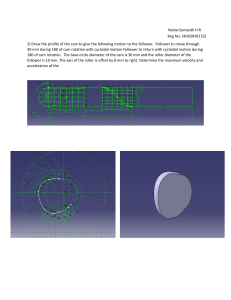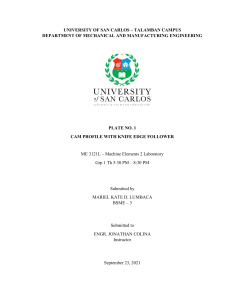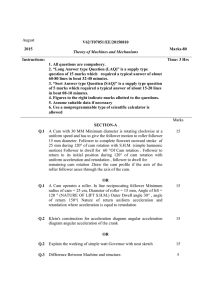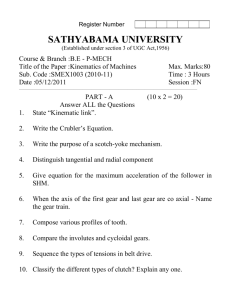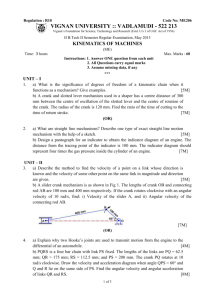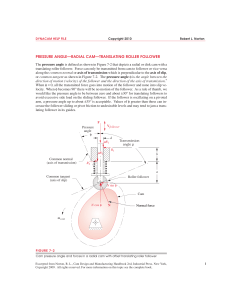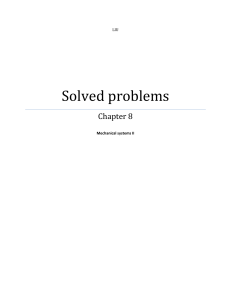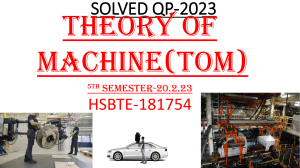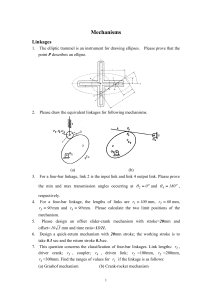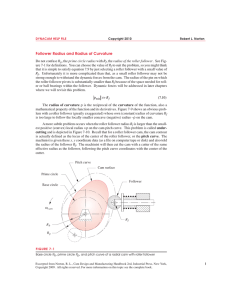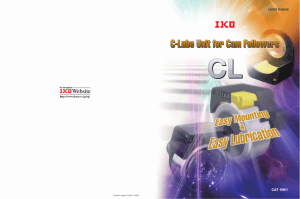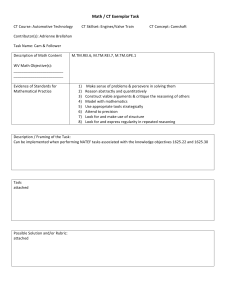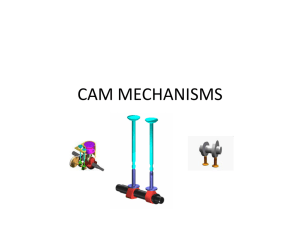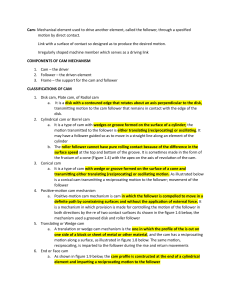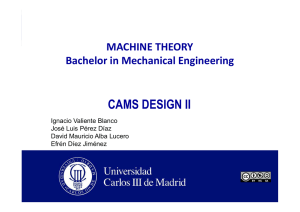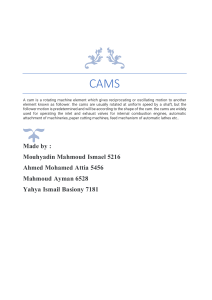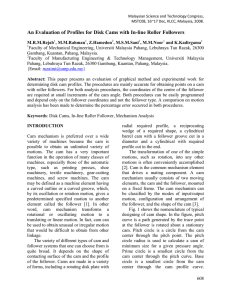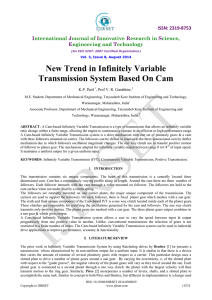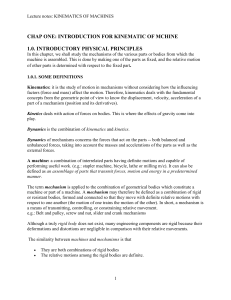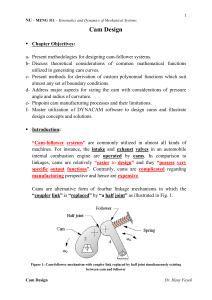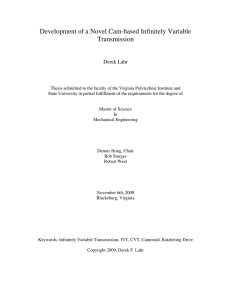ME 371 Outline.doc
advertisement
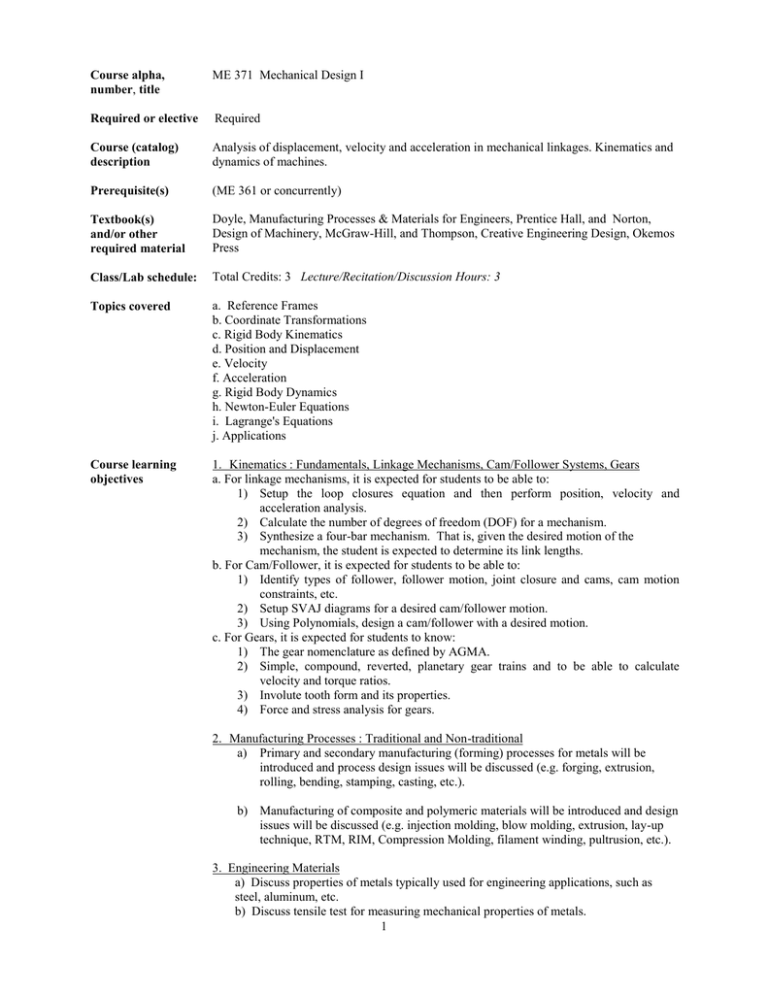
Course alpha, number, title ME 371 Mechanical Design I Required or elective Required Course (catalog) description Analysis of displacement, velocity and acceleration in mechanical linkages. Kinematics and dynamics of machines. Prerequisite(s) (ME 361 or concurrently) Textbook(s) and/or other required material Doyle, Manufacturing Processes & Materials for Engineers, Prentice Hall, and Norton, Design of Machinery, McGraw-Hill, and Thompson, Creative Engineering Design, Okemos Press Class/Lab schedule: Total Credits: 3 Lecture/Recitation/Discussion Hours: 3 Topics covered a. Reference Frames b. Coordinate Transformations c. Rigid Body Kinematics d. Position and Displacement e. Velocity f. Acceleration g. Rigid Body Dynamics h. Newton-Euler Equations i. Lagrange's Equations j. Applications Course learning objectives 1. Kinematics : Fundamentals, Linkage Mechanisms, Cam/Follower Systems, Gears a. For linkage mechanisms, it is expected for students to be able to: 1) Setup the loop closures equation and then perform position, velocity and acceleration analysis. 2) Calculate the number of degrees of freedom (DOF) for a mechanism. 3) Synthesize a four-bar mechanism. That is, given the desired motion of the mechanism, the student is expected to determine its link lengths. b. For Cam/Follower, it is expected for students to be able to: 1) Identify types of follower, follower motion, joint closure and cams, cam motion constraints, etc. 2) Setup SVAJ diagrams for a desired cam/follower motion. 3) Using Polynomials, design a cam/follower with a desired motion. c. For Gears, it is expected for students to know: 1) The gear nomenclature as defined by AGMA. 2) Simple, compound, reverted, planetary gear trains and to be able to calculate velocity and torque ratios. 3) Involute tooth form and its properties. 4) Force and stress analysis for gears. 2. Manufacturing Processes : Traditional and Non-traditional a) Primary and secondary manufacturing (forming) processes for metals will be introduced and process design issues will be discussed (e.g. forging, extrusion, rolling, bending, stamping, casting, etc.). b) Manufacturing of composite and polymeric materials will be introduced and design issues will be discussed (e.g. injection molding, blow molding, extrusion, lay-up technique, RTM, RIM, Compression Molding, filament winding, pultrusion, etc.). 3. Engineering Materials a) Discuss properties of metals typically used for engineering applications, such as steel, aluminum, etc. b) Discuss tensile test for measuring mechanical properties of metals. 1 c) Discuss stress-strain curves for metals. 4. Design-for-Manufacturing The importance of this concept to manufacturing industries will be stressed and examples will be presented illustrating its economical value. Occasionally, industrial speakers will be invited to give lecture on this topic and shed light on the importance of DFM to their industries. 5. Broader Issues in Design and Manufacturing Students will be introduced to advance numerical techniques (i.e. FEA, shape optimization methods, etc.) currently being used in industries to simulate manufacturing processes to reduce production costs. Relationship of course to ME program outcomes The following measurement standard is used to evaluate the relationship between the course outcomes and the educational-program outcomes: 3 = Strong Emphasis, 2 = Some Emphasis, 1 = Little or No Emphasis. (a) an ability to apply knowledge of mathematics, science, and engineering—3 (b) an ability to design and conduct experiments, as well as to analyze and interpret data—1 (c) an ability to design a system, component, or process to meet desired needs—3 (d) an ability to function on multi-disciplinary teams—3 (e) an ability to identify, formulate, and solve engineering problems—3 (f) an understanding of professional and ethical responsibility—3 (g) an ability to communicate effectively—3 (h) the broad education necessary to understand the impact of engineering solutions in a global/societal context—1 (i) a recognition of the need for and the ability to engage in life-long learning—2 (j) a knowledge of contemporary issues—2 (k) an ability to use the techniques, skills, and modern engineering tools necessary for engineering practice—2 (l) design, build, and test in mechanical systems area—3 (m) design, build, and test in thermal/fluids area—1 (n) application of advanced mathematics—1 (o) capstone design experience—3 Contribution to professional component: 50% Engineering Science 50% Engineering Design Person(s) who prepared this description Tim Hinds and Farhang Pourboghrat Date of Preparation 2
